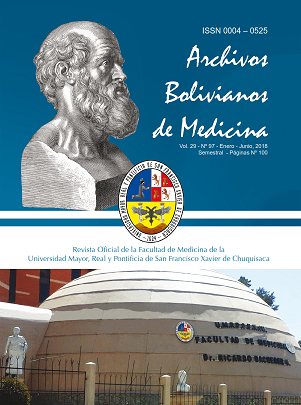EPIDEMIOLOGÍA, MANEJO INICIAL Y ANÁLISIS DE MORBIMORTALIDAD DEL GRAN QUEMADO EN UN HOSPITAL DE TERCER NIVEL DE ATENCIÓN DEL MUNICIPIO DE LA PAZ
Palabras clave:
Gran quemado, manejo inicial, morbimortalidadResumen
El presente trabajo de investigación está orientado a describir las características epidemioló- gicas de los pacientes quemados graves y analizar los factores relacionados con la morbimortalidad en el hospital de Clínicas del municipio de La Paz.
Estudio observacional retrospectivo de los pacientes ingresados en el servicio hospitalario por quemaduras graves, entre julio y diciembre de 2017.
Habiéndose registrado nueve pacientes con criterios de «gran quemado», en los que se ha estudiado variables epidemiológicas de este tipo de pacientes, diagnóstico y manejo inicial, complicaciones precoces e indicadores de morbimortalidad.
Los resultados mostraron que la superficie corporal quemada fue del 42 ± 25% y la edad 51 ± 19 años. Los pacientes permanecieron ingresados en el servicio hospitalario durante una mediana de 4 días (rango intercuartil: 2-19). Un 68% de los pacientes necesitaron ventilación mecánica, un 57% presentó alguna infección durante el ingreso, y un 26% desarrolló insuficiencia renal aguda durante la primera semana. La mortalidad en el servicio hospitalario fue del 42%. Las variables asociadas de manera independiente con un aumento significativo de la mortalidad fueron la superficie corporal quemada superior al 35% (OR 1,08; IC 95%: 1,03-1,12) y el desarrollo de insuficiencia renal (OR 5,47; IC 95%: 2,02-8,93).
La mortalidad de estos pacientes es muy alta, y viene condicionada, en gran parte, por la asistencia inicial, el porcentaje de superficie corporal quemada y el fallo renal que conllevan siendo evidente la ausencia de políticas de salud preventivas a nivel poblacional.

